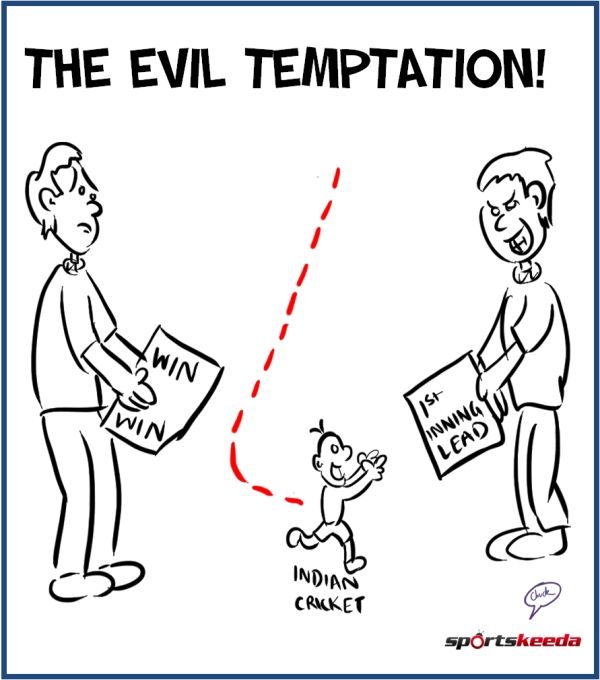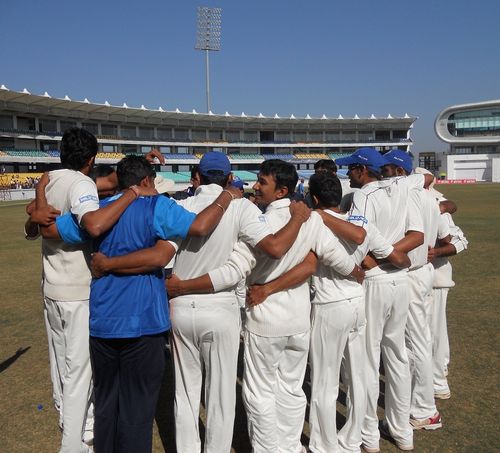
Saurashtra's journey in Ranji 2013

Saurashtra made it to the finals of the Ranji Trophy after 75 years. Though they did not have a fairy tale ending to their story, they announced their presence. For a team who made it to the finals with just 3 wins in the 10 games it played before the finals, the journey seems interesting.
Who were their war-heroes? Was it Cheteshwar Pujara, who powered them into the finals or was it a team effort that took them through? Or was it the skewed nature of the tournament’s format that helped them reach the knock-out stages? Let us peek into their journey.
The Saurashtra squad has two star players – Pujara and Sir Ravi Jadeja. Only Jaydev Unadkat has made it to the Indian team from the remaining squad.
The first match was against Gujarat. Gujarat’s squad full of Patels were put into bat by Saurashtra. The decision back-fired as Gujarat declared their innings at 9 for 600. Saurashtra took a draw-oriented approach to the daunting task. A triple century for Sir Ravi and a classic double for Sagar Jogiyani ensured that Saurashtra ended the match at a mesmerizing total of 716/3. The match belonged to Sir Ravi, who not only scored his third triple, but also picked 4 wickets in the first innings of the match.
The second match was against Hyderabad. You just can’t leave Sir Ravi out of the game. He rose to the occasion again, not with the bat but with the ball. He picked up 9 wickets in a low-scoring game and ensured that Saurashtra defended its slender first innings total and kept Hyderabad at a safe distance from chasing down the target. Other notable performances came from the Hyderabad’s debutant A Ashish Reddy who was the chief-wrecker of Saurashtra’s first innings.
Saurashtra followed up two draws with a loss against Punjab in Punjab’s own den. Jadeja’s failure with bat and ball did not help Saurashtra’s cause. Though Saurashtra’s batting line-up collapsed in the first innings, Siddharth Trivedi fought back for Saurashtra by picking 5 for 64. Punjab gained a slender lead of 115 runs on a placid Mohali track. However, Saurashtra failed to capitalize on an opportunity provided by the bowlers. Bowled out for a mere 233, Saurashtra set a nominal target of 119 runs for Punjab. The game ended on third day. This game showed Saurashtra’s increasing reliance of Ravindra Jadeja to get them through. Absence of Cheteshwar Pujara, who was on his duty against the visiting Brits, added to their woes.
Seeking their first win, Saurashtra went to Rajkot for their 4th league match against Railways. The Jacques Kallis of Saurashtra was in his element. Jadeja pushed past his previous failure to deliver another triple century. Jadeja scored his career best 331 and picked three 3 wickets to ensure that Saurashtra secured a comfortable first innings lead. Though the match ended in a draw, Saurashtra secured 3 points. The match-changing partnership in the game was between Jadeja and Kamlesh Makwana of 292 runs for the 7th wicket. In a nutshell, it was Jadeja again who took them through.
Saurashtra routed Bengal in their next match played at Rajkot. It seems to me that Jadeja was on his way to become the next demi-God of Indian cricket. Back-to-back half-centuries in both innings and 4-wicket hauls in each innings meant that Sir Sri Sri Jadeja was close to leaving an indelible mark on this Ranji season.
Such consistent performances in domestic cricket definitely portray Jadeja as a consummate candidate for a place in the Indian Eleven. And he has surely contributed significantly. Absence of single-handed match winning performances such as these and presence of single-handed match losing performances at the international level turn out to be detrimental for ‘The Sir’.
Saurashtra were hit hard by a blow. Jadeja got a call for his Test debut. Not only did he leave the Jadeja army stranded, but Saurashtra found themselves facing the then 39-time winner Mumbai in their next match. Aditya Tare and someone called Rohit Sharma struck gigantic tons and Mumbai declared their first innings on 606/5. Despite gaining a monumental 306 run first innings lead and with few overs in the bank, enforcing a follow-on looked the ideal decision. However, Agarkar chose otherwise. The match ended in a draw.
So far, Saurashtra had played 6 games, winning 1, losing 1 and drew 4 matches.
With the arrival of impact man Cheteshwar Pujara, Saurashtra’s chances against Rajasthan looked bright. But the nature of the game is such that we call it the end of the match on the 4th day itself. The match was on its way towards a result had there been a fifth day. The match was drawn and Rajasthan claimed 3 vital points.
In the last of their league games, a win for Saurashtra was necessary. And Saurashtra found their winning combo – Pujara and Jadeja. Jadeja? Yes, Dharmendrasinh Jadeja. Jadeja picked 9 for 102 and Pujara smashed a quick-fire double century to ensure that Saurashtra sailed through to the quarter-finals.
The quarter-final between Saurashtra and Karnataka was all about runs. At the end of the five-day run feast in which 1583 runs were scored, Pujara rose to fore was an impeccable 352 off just 427 balls. Pujara’s ability to play long innings, coupled with the ability to score quick runs, which in turn relies more on technique than on brute-force are fundamental elements of a legend-in-making. Saurashtra advanced on the basis of first innings lead.
Now, it was the time for semi-finals. Saurashtra v/s Punjab. Punjab had thrashed Saurashtra a few weeks back in Punjab’s own backyard. But now, they faced a resurgent Saurashtra in Saurashtra’s den. Politically or based on sheer performance, Pujara had been called for Indian ODI line-up against England. Sadly, Pujara ended-up only warming the bench rather than contributing towards Saurashtra’s success.
In a match, where each and every Saurashtrian player contributed either with the bat or ball, Saurashtra won the semi-finals by 229 runs. It was a historical moment in Ranji history. They had entered the finals for the first time in 75 years. Unless you’re a historian, you won’t find Saurashtra on the winner’s-runner’s-up list. It was Nawanagar who made it to the finals in 1937/38. They only managed to lose to Hyderabad.
What happened in the finals is very well known to us. Mumbai made mince meat of Saurashtra and Saurashtra never looked like giving a fight. They solicited services of Pujara but were denied. In the absence of big names like Pujara and Ravi Jadeja, Saurashtra surrendered meekly. Mumbai scored 355 runs in the game and yet won by an innings and 125 runs. The winning margin could have been ever bigger. Saurashtra had lost half their side for 11 runs in their second innings.
Though, Saurashtra did not have a fairy-tale climax to their journey, they would surely be the team to watch out for. Though most of their success banked on Jadeja’s and Pujara’s shoulders, I hope they find such pillars in years to come.